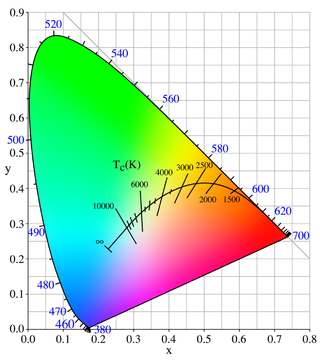
Color temperature is a parameter describing the color of a visible light source by comparing it to the color of light emitted by an idealized opaque, non-reflective body. The temperature of the ideal emitter that matches the color most closely is defined as the color temperature of the original visible light source. The color temperature scale describes only the color of light emitted by a light source, which may actually be at a different temperature.

Film stock is an analog medium that is used for recording motion pictures or animation. It is recorded on by a movie camera, developed, edited, and projected onto a screen using a movie projector. It is a strip or sheet of transparent plastic film base coated on one side with a gelatin emulsion containing microscopically small light-sensitive silver halide crystals. The sizes and other characteristics of the crystals determine the sensitivity, contrast and resolution of the film. The emulsion will gradually darken if left exposed to light, but the process is too slow and incomplete to be of any practical use. Instead, a very short exposure to the image formed by a camera lens is used to produce only a very slight chemical change, proportional to the amount of light absorbed by each crystal. This creates an invisible latent image in the emulsion, which can be chemically developed into a visible photograph. In addition to visible light, all films are sensitive to X-rays and high-energy particles. Most are at least slightly sensitive to invisible ultraviolet (UV) light. Some special-purpose films are sensitive into the infrared (IR) region of the spectrum.

An interference filter, dichroic filter, or thin-film filter is an optical filter that reflects some wavelengths (colors) of light and transmits others, with almost no absorption for all wavelengths of interest. An interference filter may be high-pass, low-pass, bandpass, or band-rejection. They are used in scientific applications, as well as in architectural and theatrical lighting.

Stage lighting is the craft of lighting as it applies to the production of theater, dance, opera, and other performance arts. Several different types of stage lighting instruments are used in this discipline. In addition to basic lighting, modern stage lighting can also include special effects, such as lasers and fog machines. People who work on stage lighting are commonly referred to as lighting technicians or lighting designers.

Color photography is photography that uses media capable of capturing and reproducing colors. By contrast, black-and-white or gray-monochrome photography records only a single channel of luminance (brightness) and uses media capable only of showing shades of gray.
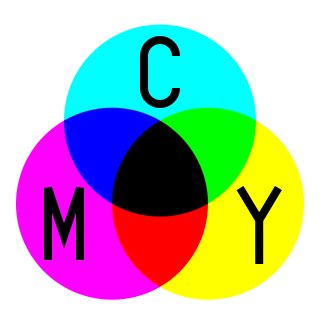
Subtractive color or subtractive color mixing predicts the spectral power distribution of light after it passes through successive layers of partially absorbing media. This idealized model is the essential principle of how dyes and pigments are used in color printing and photography, where the perception of color is elicited after white light passes through microscopic "stacks" of partially absorbing media allowing some wavelengths of light to reach the eye and not others, and also in painting, whether the colors are mixed or applied in successive layers.
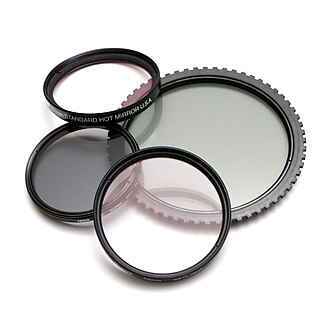
In photography and cinematography, a filter is a camera accessory consisting of an optical filter that can be inserted into the optical path. The filter can be of a square or oblong shape and mounted in a holder accessory, or, more commonly, a glass or plastic disk in a metal or plastic ring frame, which can be screwed into the front of or clipped onto the camera lens.
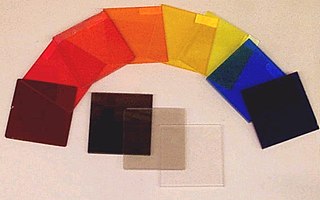
An optical filter is a device that selectively transmits light of different wavelengths, usually implemented as a glass plane or plastic device in the optical path, which are either dyed in the bulk or have interference coatings. The optical properties of filters are completely described by their frequency response, which specifies how the magnitude and phase of each frequency component of an incoming signal is modified by the filter.

Congo red is an organic compound, the sodium salt of 3,3′-([1,1′-biphenyl]-4,4′-diyl)bis(4-aminonaphthalene-1-sulfonic acid). It is an azo dye. Congo red is water-soluble, yielding a red colloidal solution; its solubility is greater in organic solvents. The use of Congo red in the textile industry has long been abandoned, primarily because of its carcinogenic properties, but it is still used for histological staining.
C-41 is a chromogenic color print film developing process introduced by Kodak in 1972, superseding the C-22 process. C-41, also known as CN-16 by Fuji, CNK-4 by Konica, and AP-70 by AGFA, is the most popular film process in use, with most, if not all photofinishing labs devoting at least one machine to this development process.
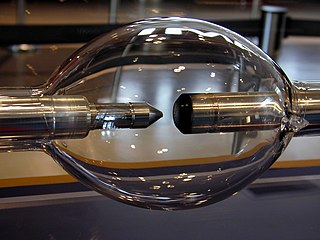
High-intensity discharge lamps are a type of electrical gas-discharge lamp which produces light by means of an electric arc between tungsten electrodes housed inside a translucent or transparent fused quartz or fused alumina arc tube. This tube is filled with noble gas and often also contains suitable metal or metal salts. The noble gas enables the arc's initial strike. Once the arc is started, it heats and evaporates the metallic admixture. Its presence in the arc plasma greatly increases the intensity of visible light produced by the arc for a given power input, as the metals have many emission spectral lines in the visible part of the spectrum. High-intensity discharge lamps are a type of arc lamp.

Day for night is a set of cinematic techniques used to simulate a night scene while filming in daylight. It is often employed when it is too difficult or expensive to actually shoot during nighttime. Because both film stocks and digital image sensors lack the sensitivity of the human eye in low light conditions, night scenes recorded in natural light, with or without moonlight, may be underexposed to the point where little or nothing is visible. This problem can be avoided by using daylight to substitute for darkness. When shooting day for night, the scene is typically underexposed in-camera or darkened during post-production, with a blue tint added. Additional effects are often used to heighten the impression of night.

Contracted from the term micro reciprocal degree, the mired is a unit of measurement used to express color temperature. Values in mireds are calculated by the formula:
Color correction is a process used in stage lighting, photography, television, cinematography, and other disciplines, which uses color gels, or filters, to alter the overall color of the light. Typically the light color is measured on a scale known as color temperature, as well as along a green–magenta axis orthogonal to the color temperature axis.
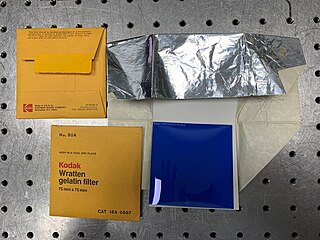
Wratten numbers are a labeling system for optical filters, usually for photographic use comprising a number sometimes followed by a letter. The number denotes the color of the filter and its spectral characteristics, and these numbers can be grouped into broad categories, but the numbering system is arbitrary within a group and does not encode any information. For example, within the photometric group of color correction filters, the 80A–80D are blue, while the next filters in numerical order, 81A–81EF, are orange. Letters almost always increase with increasing strength.

In digital imaging, a color filter array (CFA), or color filter mosaic (CFM), is a mosaic of tiny color filters placed over the pixel sensors of an image sensor to capture color information.
A colour scroller or colour changer is an electro-mechanical lighting accessory used in theater, film, dance and concerts to change the colour projected by stage lighting instruments without the need of a person to be in the vicinity of the light. A colour scroller moves plastic "gel" colour gel [actually dyed polyester and/or other base materials coated with dyes] into the beam of the light. It is generally attached to the gel frame holder at the transmitting end of a lighting fixture, so colour is introduced after the beam characteristics have been defined by the optics of the lighting instrument. Most scrollers are controlled via DMX512 protocol, but some models also utilize the RDM protocol. When colour scrollers were first introduced around 1980, a number of companies produced them, including: Avolites, GAM Products, Morpheus Lights, Rainbow, Rosco Laboratories and Wybron Inc. Now the main manufacturers are: A.C. Lighting, Apollo, Morpheus Lights and Rainbow.
In theatre lighting, a bastard color is a color, typically in a color gel, wherein the predominant color is blended with small amounts of complementary colors; for example, a "bastard orange" gel would produce predominantly orange light with undertones of blue. Bastard colors appear more natural than pure colors and are used to replicate natural light.

Photographic film is a strip or sheet of transparent film base coated on one side with a gelatin emulsion containing microscopically small light-sensitive silver halide crystals. The sizes and other characteristics of the crystals determine the sensitivity, contrast, and resolution of the film. Film is typically segmented in frames, that give rise to separate photographs.
The conservation and restoration of film is the physical care and treatment of film-based materials. These include photographic film and motion picture film stock.

















